http://www.happyhollowhoney.com/
Richard Reid in a Virgina rural area in the US began with bees 1973. Beekeeping was simple, almost only it consisted of putting on and removing supers.
By 1995 all of his bees died due to the Varroa mite. He didn’t like drugs and didn’t use any in his colonies. A package bee colony he bought also died, after only two months. He couldn’t take more, dropped the bees, and devoted himself entirely to his construction business.
Survivors
After a number of years, he discovered that a few swarms had settled in a few stacks of supers. He went and looked at these wild bees sometimes and saw that they lived on. They lived and swarmed for 12 years unattended. After a few years he was encouraged and decided in 2008 to give beekeeping a chance again.
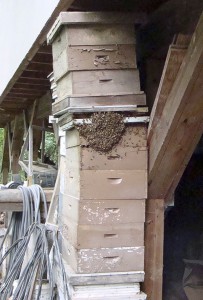 One of the feral swarms settled in his stacks of supers.
One of the feral swarms settled in his stacks of supers.
There are no big farms nearby (thus not so much of agriculture chemicals) and some smaller beekeepers were at least 3 km (2 miles) away from his bees. So the conditions for healthy beekeeping was good.
Come back
He took care of the two feral swarms and began to expand the number of colonies using these, VSH, and Russian lines. He decided again not to use any kind of chemicals against Varroa. He didn’t buy any package bees or colonies from other areas (well, none at all). He multiplied his own colonies.
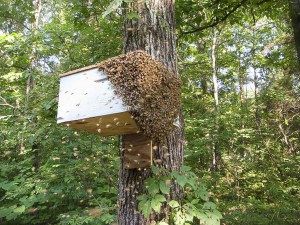 He also catches some swarms.
He also catches some swarms.
He bought however queens from different places which he believed to have resistance characteristics, VSH Carnica, Russian bees, and survivor bees from different places. He never monitored mite levels in his colonies.
Annual losses since 2008 have been between 10-15%, except after the winter of 2012-13 when 40% died. Each year, he had seen some wingless bees in some colonies. After the winter with the big losses he hasn’t seen any wingless bees. He has since bought fewer queens from outside and bred most from his own.
Every year he breeds from several “lines”, now about 18 of them. Queens are mated in his home yard. He makes many splits every year. Some of these get pupae of those he breeds. Some splits rear queens themselves.
Increasing
2015 he wintered 75 production colonies and 105 nucs. 30 of the colonies are kept in the vicinity of his home yard. There he keeps 17 of them. The nucs are also kept close in the home yard.
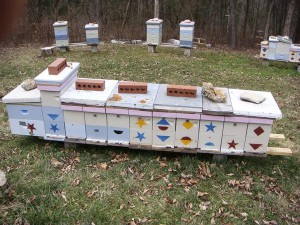 Some of his nucs and production colonies in his home yard.
Some of his nucs and production colonies in his home yard.
He has altogether nine apiaries. He wants to have at least 10 colonies in each apiary, but he hasn’t reached that goal yet for most of them. He is now aiming to increase his number of production colonies to 100 and the nucs to 150, as well as an additional 2 apiaries.
Regarding cell size, the great majority of brood frames in his colonies are Mann Lakes standard plastic frame with plastic foundation. (http://www.mannlakeltd.com/beekeeping-supplies/category/page19.html) The cell size on those are 4.95 mm. The rest of the frames in the honey boxes have a larger cell size. Some frames are started without a foundation. The intention is that the bees will build some drone comb there. He wants to flood the area with desired drones. But bees are also building fine worker brood in some of these frames, especially in the nucs.
Selling nucs, queens and honey
He split the nucs in the spring and sells one part with the queen, saves the rest to build up a new nuc. It’s usually used for a mating nuc or nuc production depending on the season.
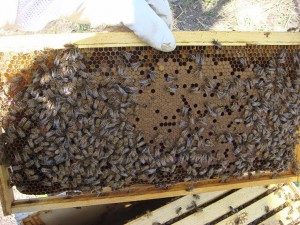 One of the worker brood frames built by the bees without the help of a foundation.
One of the worker brood frames built by the bees without the help of a foundation.
He usually has a very good spring flow that will carry the colonies through the rest of the year, but there’s usually a dearth in the summer, which means the nucs may need to be fed sugar syrup to prepare for winter. 2015 he had so much spring honey production, he only had to feed about 20% of the nucs for winter.
He says that now he has enough resources so he can share honey between production hives and nucs. Thus he feeds less. He usually only feeds a handful of production hives (mostly new ones) to prepare for winter. The production colonies go through winter on large supplies of honey. Quite often he has extracted honey in April. You can say he uses his colonies as a honey storage.
Richard Reid’s locally adapted Varroa-resistant bee stock
• There are at least 3 km to apiaries with other bee colonies than of his stock.
• The area where he lives is not a highly developed agricultural area, so there is not so much agricultural chemicals there as can be the case in many other areas.
• He started with bees which had a degree of varroa resistance.
• In most brood combs, he uses small cell size.
• He doesn’t bring in colonies (such as packages) from outside the area with his bees.
• He splits nucs (with new queens from his breeder queens) to make more nucs, which later become production colonies or bees for sale. He also splits a few of the smaller, less productive, production colonies to create new nucs.
• He doesn’t requeen on a regular schedule. He has some colonies with queens finishing their 3rd and 4th season.
• The bad colonies die or have their queens replaced.
• He breeds after queens from many different lines each year.
• He tries each year just a few queens from other breeders.
Encouragement to all beekeepers
Richard Reid is one of several beekeepers who has managed to breed a varroa resistant locally adapted bee stock. Let us be encouraged by that and despite what some other beekeepers of all kinds say, that this is not possible. How can one be so ignorant to what others achieve? Make use of what you can of the experiences of Richard Reid.
When he started, he hadn’t many bee colonies, so even if you have few colonies you can do something.
Perhaps your circumstances are such that it is good to monitor mite levels in your colonies. There are various methods, for example the Bee Shaker (http://www.elgon.es/diary/?cat=85).
Don’t take it as a failure if you choose to use pesticides at times. Each of us decides what is appropriate for ourselves and our bees, in consultation with the laws of your country. A treatment that doesn’t involve any chemicals at all is to remove all capped brood (worker and drone brood) twice, a week apart. It is effective, weakens the bee population as well though, but not the health of the bees. The bad colonies get new queens as soon as possible.
Next season will always be better!
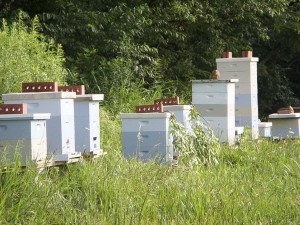
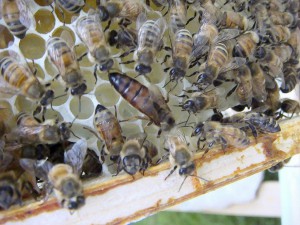
Great article. Quite similar thinking and management as I try to apply in my apiaries. I have gleaned a few ideas from Kirk Webster in Vermont, USA: http://kirkwebster.com/
Kirk Webster and Mike Palmer have similar management systems in many ways. Mike is the one that I’m friends with. He has inspired my expansion with his sharing of details of queenrearing, splitting, wintering nucs, honey production, and the multitude of details associated with these. I have a few of Kirk’s queens from a friend’s purchase in 2014. Kirk kickstarted Mike’s nuc operation years ago.
Hi Richard,
great work! Congratulation!
Are there any essentials that Erik might miss in the contribution about your work, that you think that are absolutely necessary to follow. You spoke about a “multitude of details”…..
Secondly, I wonder whether you use plastic frames instead of wax frames. My experience is, that bees don’t like plastic. I have used Rovergarden plastic frames…Don’t you think the use of wax would be beneficial for your operations?
I was referring to beekeeping in general involving a multitude of details. It’s a lifelong study and you never know it all.
I really wonder what it is that creates successful beekeeping here. It has to be a variety of things contributing to the whole outcome. Bees seem to be able to deal with fair amount of adversity, but at some point they reach the tipping point. The nucs have a slightly better survival rate than the production hives, and I run a high percentage of nucs, the majority with young queens (a few of the nucs have older breeders). The big production colonies are the real test of survival. Even those have only had 10-12% losses the last several years. Some of those losses were old queens since I don’t requeen on schedule.
If you add an ample amount of your own bees’ wax to your plastic frames or foundation, many bees will draw it out beautifully even without a flow. It makes all the difference. I’ve just started doing this in the last two years.
One more reason to avoid wax foundation here in the US is the build up of miticides. By waxing my own plastic the majority of the wax is my from my own untreated bees.
Thanks Richard,
and yes you are right, you have to control the quality of wax. I personally avoid using wax which was in contact with honey or pollen from any industrial agriculture as e.g. rapeseed. Most of these chemicals are hydrophobic and will be distributed in the wax as well. In Germany the rapeseed is contiminated on average 10 times with 15 different herbicides/pesticides/insectizides until harvest. I wait for Acacia, limetree, heather and so on to collect my wax. And secondly you need good wax press. But I heard Myron Kropf in the US is making good ones….
Rüdiger and Richard,
Myron makes good wax foundation rollers. He can make whatever cell size you want I understand, but I think he has 4.9 in stock. What makes his rollers so good is that the cell bottoms are deep as they are naturally. It makes it easier for the bees to draw out the foundation correctly. His telephone number: +1(870)458-3002. His prices are reasonably.
There are quite good foundation molds to on the market. They may cost a lot too. http://www.swienty.dk/shop/default.asp?catid=1121
If you have a good master foundation you can make your own mold: http://resistantbees.com/guss_e.html
Sounds great, as a second year Bee Keeper I aspire to have this much success.
Thanks Richard for sharing.
Great story! I always love hearing success stories about other TF beeks and gain from the lessons they’ve learned.
I especially like how you pointed out that he doesn’t requeen regularly. I also feel like if we requeen on an annual basis, we can’t really know the quality of the queens. It kind of takes a couple of years to really separate the spectacular ones from the merely ok or good.
Very interesting article I believe in his method
This is encouraging. I am leaning in the same direction. Difficult to keep bees from mingling with other apiaries where I am, though, because we all flee the ravaging Asian hornets in midsummer to pastures up mountain. Last year a hundred hives were set down on a plot only an acre from mine. Lots of raids ensued. Hard to keep the resistant lines pure in those conditions. Happy to read this article. This is good work you are doing and very useful to record it for other beekeepers. Thanks.
I know absolutely nothing about beekeeping! However, I am very concerned about bee populations and our environment. We have 3 acres in the middle of our small town. We would be very happy to have someone place bee colony on our property. We are very private up on our hill. We are a retired couple with no children in our cul de sac. Would anyone be interested? We’re not interested in money. We only want to promote the bees! We are in East Tennessee.
We don’t re queen every year we have had bees sense 2006 we just keep a few hives 6-7 once in awhile we give my sister a few hives. we love working with them.we don’t treat them for Varroa mite.
I think wax foundation is fine if you can get it from a fairly clean source, but I haven’t had problems with plastic unless there is no flow or the bees have stripped all the wax off the plastic. For me plastic frames were one of the big reasons was that it was so much easier to expand quickly and economically. The 4.95 cell size seems to work fine in the brood nest, but I am not convinced that it is a large component of success as I have had a number of colonies on larger cells in the brood nest and they do fine too.
I find these plastic frames from Mann Lake very well accepted by the bees when I coat them with a lot of wax. Actually about the same amount as you use for a wax foundation. I use only my own wax for this. It’s more than they need, but the bees have no problem using the wax and make fine combs. And with plastic frames you get more cells per frame compared to tree and wax foundation, and more straight and more worker brood (normally). Though the bees need drone brood as well as you have said.
Also I and others have experiences that tell us small cells are not an absolute requirement for having resistant bees. But there are also experiences saying bees on small cells have smaller varroa populations – at least if there are not too many of large cell and not resistant bees close to small cell bees. It may be that small cells are more important for resistance build up in a stock. And when your stock is well resistant it can handle differences in cell size better (The total of hives in an apiary). And after all when bees draw their own comb totally om their own, for example in a high enough TBH hive, worker cell size can vary a lot and mainly are quite small closer to the entrance and the bottom. There is probably a reason for this.
This is encouraging for me as I take a similar journey. I have adopted many of the ‘natural’ beekeeping methods but hardest mentally has been the leap of faith into chemical-free management. It’s early days for me but the indications are positive. The biggest cost seems to be in my own time to establish management methods and equipment that suit this approach. Thanks for blogging this news.